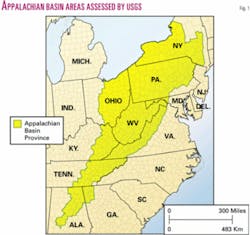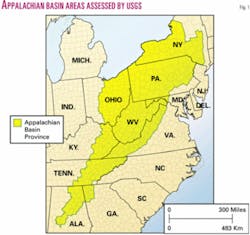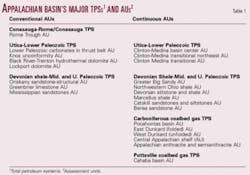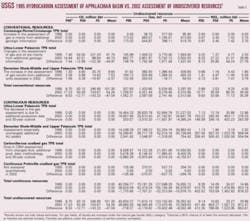Petroleum systems succeed play basis in Appalachian basin resource estimate
The US Geological Survey (USGS) periodically conducts subjective probabilistic assessments of the technically recoverable undiscovered hydrocarbon resources of the US and of the world.1 2 3
In addition, the USGS prepares forecasts of that portion of the technically recoverable resources that may be economic under specified conditions of supply, demand, and price.4
Depending on priorities, regional hydrocarbon assessments of the US are revised every 5 to 10 years. These assessments of undiscovered hydrocarbons supplement the data on hydrocarbon reserves that are reported annually by the US Department of Energy, Energy Information Administration.5
In between assessments, USGS assessment geologists conduct research and compile geologic and production data that may be used to improve future assessments. This new information commonly effects changes in the way the USGS defines "plays" or "assessment units" from assessment to assessment. Furthermore, USGS assessment methodology is in a constant state of evolution and changes to some degree from assessment to assessment.
As a result of these changes in methodology, new geological concepts, and additional geological information, these periodic assessments are never directly comparable. Overall differences in the methodology used by the USGS in the 1995 and 2002 assessments may be obtained by comparing Schmoker, 19996 (continuous accumulations) and Schmoker and Klett, 19997 (conventional accumulations) with Schmoker, 19968 (continuous accumulations), Gautier and Dolton, 19968 (conventional accumulations), and Rice, Young, and Paul, 199610 (coalbed gas).
In 2002, coalbed gas was assessed using the continuous methodology rather than by using the 1996 specialized methodology of Rice, Young, and Paul.10
The USGS 1995 National Oil and Gas Assessment was based upon "plays," which emphasized the geology of the reservoirs and traps and to a lesser extent the source rocks and migration paths of hydrocarbons from source to reservoir and trap. In contrast, the 2002 NOGA assessment utilized the "total petroleum system" (TPS) concept.7
The TPS methodology requires an identification of the major source rocks, an understanding of the timing of the generation and expulsion of hydrocarbons from their source rocks relative to the time of formation of potential traps, and a determination of the possible migration paths of hydrocarbons from their source rocks into the reservoirs and traps of the basin. In the words of Schmoker and Klett, 1999,7 "... play analysis is based on the similarities of the rocks in which accumulations occur." In the analyses of total petroleum systems, "particular emphasis is placed on the similarities of the fluids of the accumulations."
For assessment purposes, petroleum systems are subdivided into "assessment units" (AU), which are volumes of rock of similar geologic characteristics. In both types of assessments, however, the assessing geologist presented the petroleum geology and geochemistry, from source rock to reservoir and trap, of the "play" or of the AU to the NOGA assessment team.
The forecast span for the USGS 1995 National Assessment was not time-limited. In contrast, for the USGS 2002 National Assessment the forecast period in which hydrocarbon resources would be discovered was generally taken as 30 years, the length of time that the USGS assessment team perceives as reasonable for extrapolation of currently available geologic and production data, current technology, and societal and financial conditions.7
Assessment variances
In spite of the differences in methodology and geologic data from assessment to assessment, it is fair to ask if the results of the more recent assessment show more or less potential for undiscovered resources than the previous assessment.
It is the purpose of this article to compare the results of the USGS 1995 National Assessment of the hydrocarbon resources of the Appalachian basin with those of the 2002 National Assessment to explain, in a general way, the major reasons for the differences between the two assessments.
In general, the USGS assesses hydrocarbon accumulations as conventional or continuous (unconventional).6 7
Conventional accumulations, which are commonly associated with geologic structures and stratigraphic changes, have a relatively well-defined, local distribution and exhibit a gravity segregation of gaseous and liquid hydrocarbons and formation waters within their traps.
In contrast, continuous accumulations are commonly widespread and "do not owe their existence to the buoyancy of oil or gas in water."6 Although continuous (unconventional) accumulations are noted for their almost ubiquitous distribution of hydrocarbons, they commonly contain small areas of conventional hydrocarbon accumulations within their boundaries.
In general, tight sands, basin-center accumulations, black shales rich in organic matter, and coalbed methane accumulations constitute the reservoirs for continuous accumulations of hydrocarbons.
To facilitate the comparison of the 1995 and 2002 assessments, we have in retrospect superimposed our 2002 concept of Appalachian petroleum systems upon the plays that were defined for the Appalachian basin in 1995.1 The principal petroleum systems currently identified by the USGS assessment team are listed in Table 1. The results for the 1995 plays and 2002 assessment units may be found at: (http://energy.cr.usgs.gov/oilgas/noga/index.htm).
A comparison at the petroleum system level is shown in Table 2. In general, at the mean, the amount of undiscovered oil assessed decreased from the 1995 to the 2002 assessment, from 101.3 million bbl of oil to 54.26 million bbl. This decrease was largely the result of the assessment of less oil in the Cambrian and Ordovician carbonate AUs because of improved field size distribution data. These data showed smaller field sizes for the last third of the fields discovered than did the data for the 1995 assessment.
The total assessed amount of undiscovered gas decreased by about 10 tcf largely because of decreases in the assessed amount of continuous gas. In spite of additions of about 1.9 tcf from the inclusion of the Marcellus shale in the 2002 Devonian shale-Middle and Upper Paleozoic TPS assessment (which maintained the amount of assessed gas for all Devonian shale continuous AUs about constant), decreases of 4.4 tcf in Silurian tight sands and 6.2 tcf in Carboniferous coalbed gas assessments made up a large part of the difference.
The decrease in the gas assessment for Silurian tight sands resulted mainly from the 30-year outlook used in the 2002 assessment versus the indefinite outlook period envisioned for the 1995 assessment.
Most of the decrease in the estimate of undiscovered coalbed methane was in the northern part of the Appalachian basin, in Pennsylvania and West Virginia, where new development within the 30-year time frame of the assessment is expected to occur primarily within the relatively small area presently defined by producing wells in southwestern Pennsylvania and northern West Virginia.
Much of the remainder of the Northern Appalachian basin was not assessed for CBM in the 2002 assessment because of the general lack of exploration in the region, the relatively low thermal maturation and gas-in-place values in that area, and our judgment that this area would not be as aggressively developed as the present area of exploration and production within the assessment time frame.
Mean assessed values for natural gas liquids increase significantly from the 1995 to the 2002 assessment (Table 2). This increase included the potential for additional oil accumulations, such as those that are associated with the continuous gas accumulations in Silurian tight sands and Devonian gas shales.
References
1. Gautier, D.O., Dolton, G.L., Takahashi, K.I., and Varnes, K.L., eds., "1995 National Assessment of United States Oil and Gas Resources-Results, Methodology, and Supporting Data," US Geological Survey Digital Data Series DDS-30, 1996, Release 2.
2. US Geological Survey World Energy Assessment Team, "US Geological Survey World Energy Assessment 2000-Description and Results," USGS Digital Data Series DDS-60, 2000, multidisc set, Version 1.1.
3. Milici, R.C., Ryder, R.T., Swezey, C.S., Charpentier, R.R., Cook, T.A., Crovelli, R.A., Klett, T.R., Pollastro, R.M., and Schenk, C.J., "Assessment of undiscovered oil and gas resources of the Appalachian Basin Province," US Geological Survey Fact Sheet FS-009-03, 2003, 2 p.
4. Attanasi, Emil D., "Economics of the 1995 National Assessment of United States Oil and Gas Resources," US Geological Survey Circular 1145, 1998, 35 p.
5. Energy Information Administration, "US Crude Oil, Natural Gas, and Natural Gas Liquids Reserves 2001 Annual Report," DOE/EIA-216(2001), 2002, 160 p.
6. Schmoker, J.W., "US Geological Survey assessment model for continuous (unconventional) oil and gas accumulations—the "FORSPAN" model," US Geological Survey Bull. 2169, 1999, 9 p. (http://pubs.usgs.gov/bul/ b2168/b2168.pdf).
7. Schmoker, J.W., and Klett, T.R., "US Geological Survey model for undiscovered conventional oil, gas, and NGL resources—the Seventh Approximation," US Geological Survey Bull. 2165, 1999, 7 p. (http://pubs.usgs .gov/bul/b2165/B2165.pdf).
8. Schmoker, J.W., "Method for assessing continuous-type (unconventional) hydrocarbon accumulations," in Gautier, D.L., Dolton, G.L., Takahashi, K.I., and Varnes, K.L., eds., "1995 National Assessment of United States Oil and Gas Resources-Results, Methodology, and Supporting Data," US Geological Survey Digital Data Series DDS-30, 1996, Release 2.
9. Gautier, D.L., and Dolton, G.L., "Methodology for assessment of undiscovered conventional accumulations," in Gautier, D.L., Dolton, G.L., Takahashi, K.I., and Varnes, K.L., eds., "1995 National Assessment of United States Oil and Gas Resources-Results, Methodology, and Supporting Data," US Geological Survey Digital Data Series DDS-30, 1996, Release 2.



